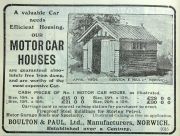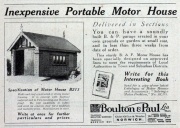Boulton and Paul























































































See also Boulton Paul Aircraft.
of Norwich, Norfolk
formerly W. S. Boulton and Co
1864 Moved to the Rose Lane Foundry formerly James Watts and Co
1875 Mention of William Staples Boulton and Joseph John Dawson Paul of the Rose Lane ironworks.[1]
1869. Had a retail shop in Norwich until this date when they sold it. Exhibit at Queen Street Mill Museum.
1887 Partnership dissolved. Joseph John Dawson Paul and James Sendell trading as Boulton and Paul.[2]
1897 Became public company. The company was registered on 13 December, to acquire the business of constructional engineers, horticultural builders etc of the firm of the same name. [3]
1900s By the early 1900s, Boulton and Paul Ltd was a successful general manufacturing firm.
1906 Started to produce a marine type four-cylinder four-stroke engine giving 16 hp at 1,300 RPM
1911 Royal Agricultural Show. Horse drawn plough for cutting turf. [4]
1913-1917 For a list of the models and prices of Marine Motors see the 1917 Red Book
1914 Manufacturers of portable buildings. Specialities: galvanized wire netting, horticultural building, lighting, pumping and heating engineering, portable and permanent building garden requisites. Employees 650. [5]
1914 Directors: Joseph John Dawson Paul, J.P., D.L. (Chairman), Henry ffiske (Managing Director), W. H. ffiske, G. M. Chamberlin, J. D. Paul,Jun.
1916 Established the aircraft department which rapidly became one of the most important producers of aircraft for the military[6]. Began to construct aircraft under contract including 550 of the Royal Aircraft Factory FE.2b. During the war the company built more Sopwith Camels than any other manufacturer. Success as a builder of aircraft led to the company forming a design department but none of its resulting aircraft made a significant impact while the war lasted. The P.3 Bobolink fighter was overshadowed by the Sopwith Snipe and the Armistice beat the P.7 Bourges fighter-bomber into production.
1918 Started developing all-metal construction for aircraft.
Boulton Paul's aircraft were flown out of Mousehold Heath in Norwich - an area which became the first Norwich Airport.
1919 Exhibited the Chain-Helice water lifter
1919 Introduced the Electolite series of engines. The last one was produced in 1932. [7]
1920 May. Issued catalogue on standard permanent wooden houses. [8]
1920. Showed a chain elevator for raising water at the Darlington Agricultural Show. [9]
1922 Directors: J. J. D. Paul (Chairman) H. Ffiske, W. H. Ffiske, Sir G. M. Chamberlin, Kt., S. Howes, Capt. J. D. Paul, G. E. Ffiske.
1922 Mr Richard Allthorpe, of the wire netting department, resigned and was succeeded by Mr Walter Murray.[10]
1924 Boulton and Paul produced a new twin-engined day-bombing machine, the Bugle. This machine was fitted with two "Jupiter" engines, and was of the biplane type, with tractor screws. Its wings had a span of 62ft. 6in., and a total area of 932 square feet ; with a gross weight of 8760 lb. , it had a useful load of 3681 lb., and a surface loading of 9. 2lb per square foot. At ground level its speed was 120 mph. It can climb to 10,000ft in 15 minutes, and to 15,000ft. in 39 minutes. [11]
1926 Made the frames for the R101 airship.
Boulton and Paul made their mark with the introduction of powered and enclosed defensive machine gun turrets for bombers. Their 1926 Sidestrand twin-engined biplane bomber, which could fly at 140 mph, had an exposed nose turret which was clearly inadequate. The subsequent Overstrand bomber in 1933 featured the world's first enclosed, power-operated turret, mounting a single Lewis gun and propelled by compressed air. The company licensed a French design of an electro-hydraulic four-gun turret which became a major feature of their future production. In addition to fitting turrets to bombers, Boulton Paul was to install them in fighters. Boulton Paul's chief aircraft designer was John Dudley North, who had moved to them from Austin's Aircraft Department.
1933 Aeroplane designers and constructors. Head office and works. Norwich. London Office: 139 Queen Victoria Street, London E.C.4.[12]
1934 The aircraft building business was separated from the main construction business and sold as a public company, Boulton Paul Aircraft Ltd; initially it leased space at Norwich Airport[13] and later moved to Wolverhampton.
1961 Constructional engineers, wood workers, manufacturers of wire netting and chain link fencing, and fencing contractors. [14]
1963 Joined the Multi-Storey Construction Association of Glasgow.
1964 Sold their wire and wire products interests to Tinsley Wire Industries[15]
1968 Supplied structural steelworks for the Winfrith power station. [16]
1968 Acquired by BET
See Also
Sources of Information
- ↑ Norfolk News - Saturday 04 December 1875
- ↑ Norfolk Chronicle - Saturday 02 April 1887
- ↑ The Stock Exchange Year Book 1908
- ↑ The Engineer of 7th July 1911 p27
- ↑ 1914 Whitakers Red Book
- ↑ The Times, 30 October 1934
- ↑ A-Z of British Stationary Engines by Patrick Knight. Published 1996. ISBN 1 873098 37 5
- ↑ The Engineer of 7th May 1920 p488
- ↑ The Engineer of 9th July 1920
- ↑ The Engineer 1922/08/11
- ↑ The Engineer 1925/01/02
- ↑ 1933 Who's Who in British Aviation
- ↑ The Times, 30 October 1934
- ↑ 1961 Dun and Bradstreet KBE
- ↑ The Times, Jan 15, 1964
- ↑ The Engineer of 8th March 1968 p399
- [1] Wikipedia

